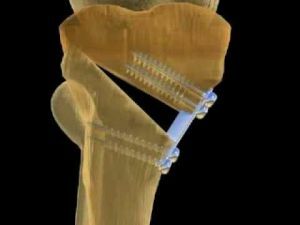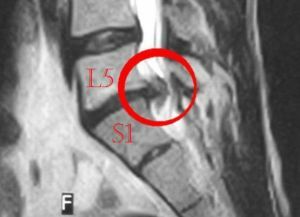 Scientists to date, almost all the anomalies in the structure of the human skeleton are known. Particular attention is paid to an important part of the whole organism - the spine, because mobility and further vital activity depend on it.
Scientists to date, almost all the anomalies in the structure of the human skeleton are known. Particular attention is paid to an important part of the whole organism - the spine, because mobility and further vital activity depend on it.
Among the anomalies in the structure of the spine, there is one feature that has a somewhat protracted character of manifestation - lumbarization of S1.
What is it, and how to deal with it after detection?
Contents of the article
- Characteristics of the anomaly
- Consequences of the vertebra detachment
- Classification of the presented pathology
- Causes of the disease
- Symptoms and diagnosis of the disease
- How to treat the pathology?
- Is it possible to prevent anomaly
Characteristic of the anomaly
The lower part of the spine, assuming the entire load of the musculoskeletal system, is called the sacrum. It consists of five vertebrae, connected by syndesmosis, connective tissue of a more stable structure unlike analogues of intervertebral discs.
Lumbarization of S1 is called an anomaly, where the upper vertebra in the sacrum is separated from the rest.
This separation can occur in different manifestations, so that the person may have distinctive symptoms and signs.
Although this anomaly can not be detected throughout life, since it has no characteristic symptoms. The presented feature of the structure of the spine is found in 1% of the total population of the planet.
If after separation no further changes occur, possibly complicating the situation, a person without appropriate diagnosis will not guess about the presence of the presented disease.
Consequences of vertebra detachment
The lumbarization of the spine of S1 does not always go without consequences. 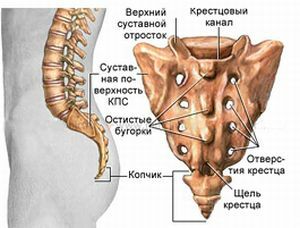
Often specialists who observe patients who complain of back pain determine their complications.
As the negative consequences, the following features can be distinguished:
- anomaly leads to a significant weakening of the lumbar functionalities;
- possible displacement of the sacrum posterior;
- in the aftermath of separation there is a redistribution of the center of gravity of the trunk;
- there is a curvature of the spine.
Classification of the presented pathology
As described above, the lumbarization of S1 has various forms of its formation, so the character of the vertebra is divided into two types:
- Complete branch - in case of such a change, the upper vertebra of the sacrum is a separate full segment,lumbar department.
- Incomplete separation of - "discontinuities" of some parts are formed, maintaining the connection of the superior vertebra of the sacrum with the rest. With this manifestation of the disease, the patient experiences partial immobility in the lumbar region, as well as severe pain.
Anatomical changes are also subdivided into varieties:
- one-way compartment - occurs only on one side;
- bilateral - complete separation occurs, which is similar to the last lumbar or the first sacral vertebra.
In case of untimely diagnosis of pathology, the patient develops a spondylosis disease - bone proliferation along the articular processes.
Causes of the disease
 As for the reasons, it can be a little disappointing, because the activity and lifestyle of a person, the appearance of pathology is almost independent, because lumbarization is a congenital anomaly.
As for the reasons, it can be a little disappointing, because the activity and lifestyle of a person, the appearance of pathology is almost independent, because lumbarization is a congenital anomaly.
As the reasons it is possible to allocate such important aspects, which absence, probably, would not give rise to the presented disease.
Such aspects include:
- heredity is a fundamental factor in the emergence of pathology, which should be taken into account more closely;
- presence of infections and intoxication during embryo development;
- use of alcohol and other bad habits of a pregnant woman;
- do not get carried away with taking contraceptives, as their chemical composition can have such an adverse effect;
- presence in pregnant gynecological diseases.
Planning a child should begin long before pregnancy to prevent similar anomalies in fetal development.
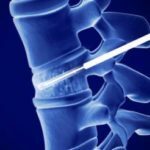 With compression fracture and some other injuries, the support functions of the spine will restore the vertebroplasty.
With compression fracture and some other injuries, the support functions of the spine will restore the vertebroplasty.
A dangerous and unpredictable disease, osteonecrosis can lead to the most unfortunate consequences and complete disability of a person if timely and quality treatment has not been started.
Symptoms and diagnosis of the disease
Pain sensations in the lumbar region appear only in the case of nerve pincers, blood supply disorders and changes in soft tissues.
On the localization of pain, experts identify two forms of the disease:
- Lumbar - this form is characterized by pain in the lower back and along the entire spine. Often, such manifestations are aching and can somewhat decrease after taking anti-inflammatory drugs. If suddenly there was a bruise of the sacrum, as a result of which there was a displacement of the separated vertebra, the pains are transformed into acute ones with characteristic lumbago.
- Sciatic - painful sensations "give" to the buttock and leg. Such manifestations arise from the pinching of the nerve process.
Often the patient, along with pain, experiences a violation of the sensitivity of the skin in the lumbar region. With the infringement of the nerve process, mobility limitations are possible.
First of all, the patient will be sent to X-ray, because with the help of the picture it is possible to diagnose pathology and the nature of its formation.
In case if the specialist does not see the changes in the image, it may be followed by an additional diagnosis of MRI.
How to treat a pathology?
The manifested symptoms in the form of painful sensations can only be weakened somewhat. 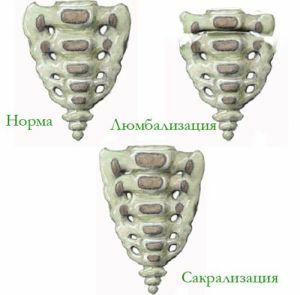
For example, take painkillers and anti-inflammatory medications if necessary, the appointment of which should be done by the attending physician.
In addition to taking medications for patients diagnosed with lumbarization of the s1 vertebra, this treatment is prescribed:
- massage of the lumbar region;
- exercise therapy;
- various physiotherapeutic procedures;
- during periods of exacerbation it is necessary to wear a corset;
- in particularly serious cases requires surgery.
Surgical intervention will follow only after the unsuccessful passage of all these methods of eliminating pain.
Also, the operation is assigned only if the person is immobilized for a long time.
During the operation, the separated vertebra is fixed with the help of plates, and between it and the rest of the sacrum an additional artificial disc is installed to prevent its further displacement, which leads to complications.
Is it possible to prevent anomaly
Prevention of the presented anomaly, according to experts, is impossible, because it is a congenital disease. But for caution, a woman during pregnancy must observe the right way of life, do not abuse alcohol and other bad habits.
Also, it should not be for a long time in the premises with chemical vapor from colored products.
Be wary of finding one position for a long time. Do not sit on stiff chairs or in soft armchairs.
This situation provokes a static pressure on the sacrum and a cut vertebra, which may result in a displacement of the segment.
Pathology sometimes does not pose a threat to human health, but when it is detected, the recommendations of the attending physician should be fully respected in order to prevent complications that cause pain and suffering.


